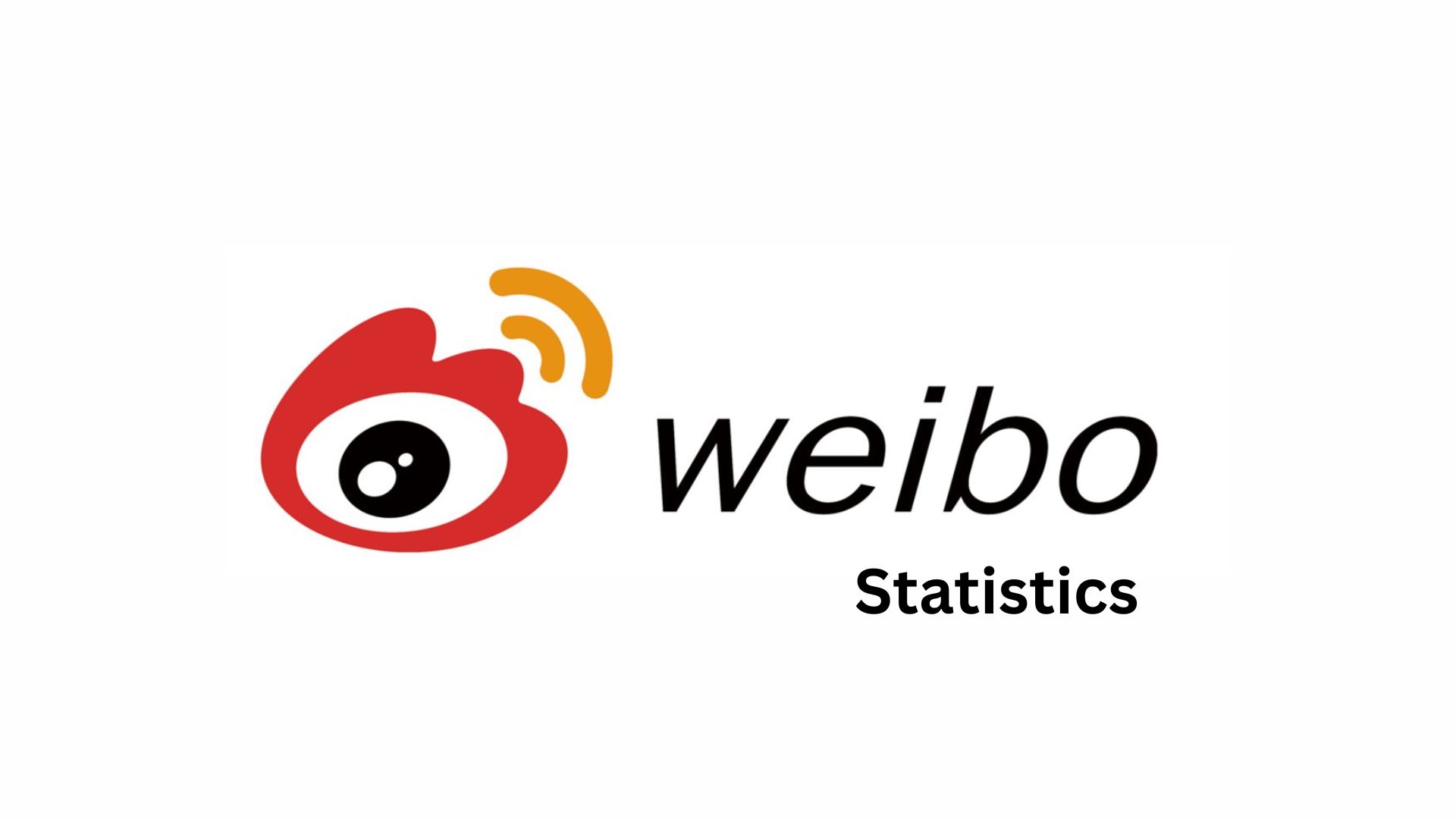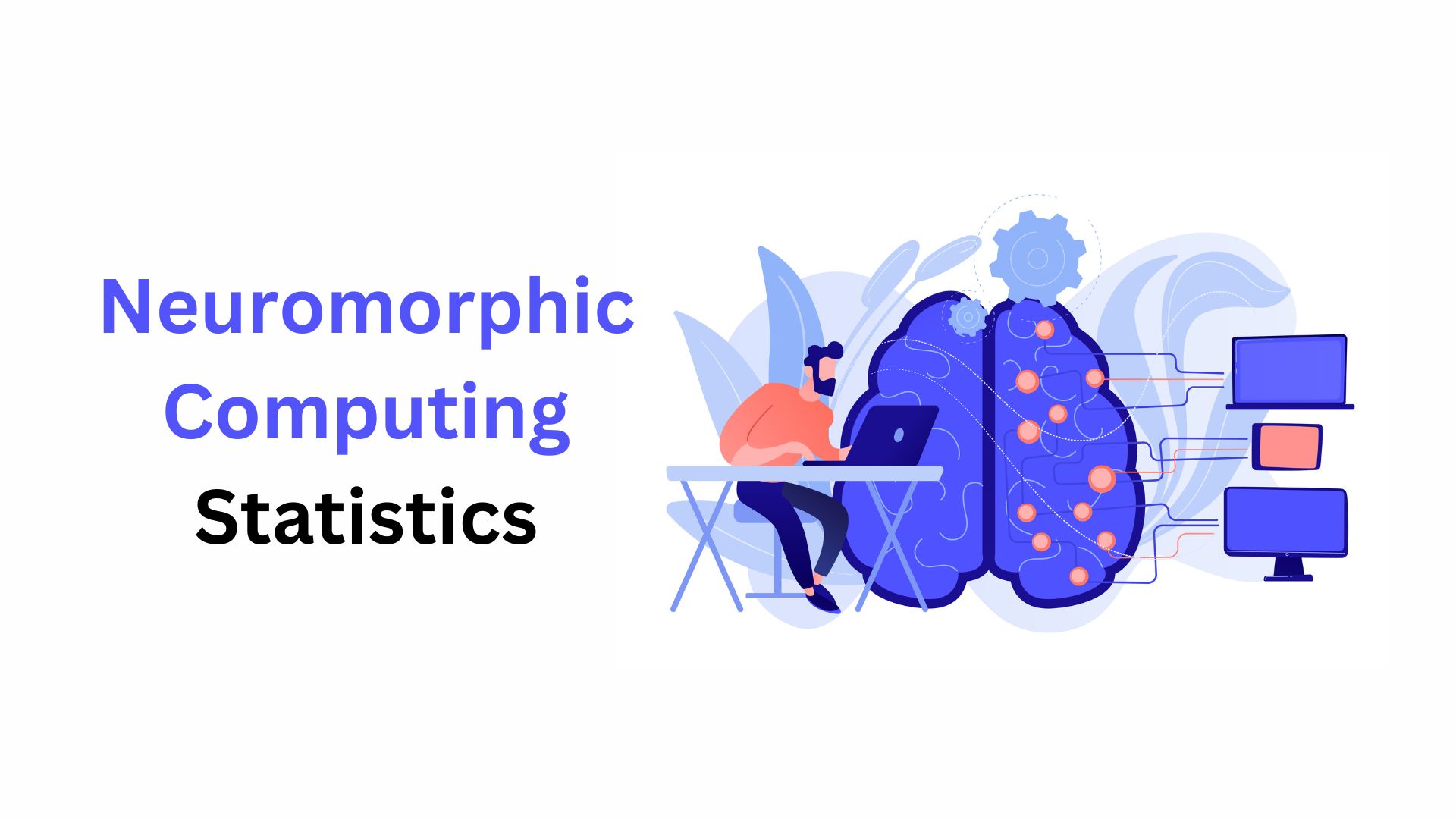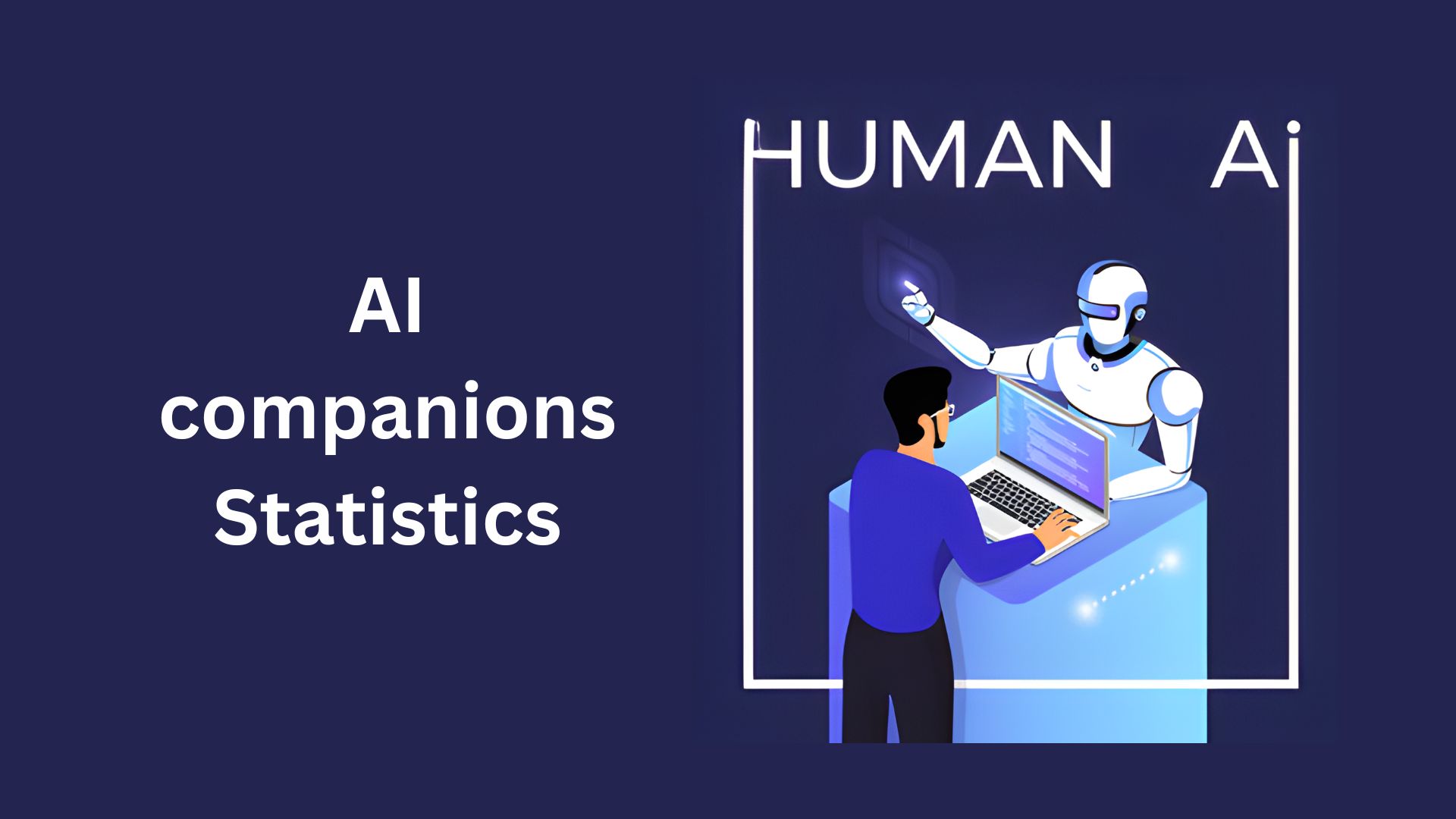Tokenized Assets Statistics By Market Size, Industry, Classes and Facts (2025)
Updated · Nov 24, 2025
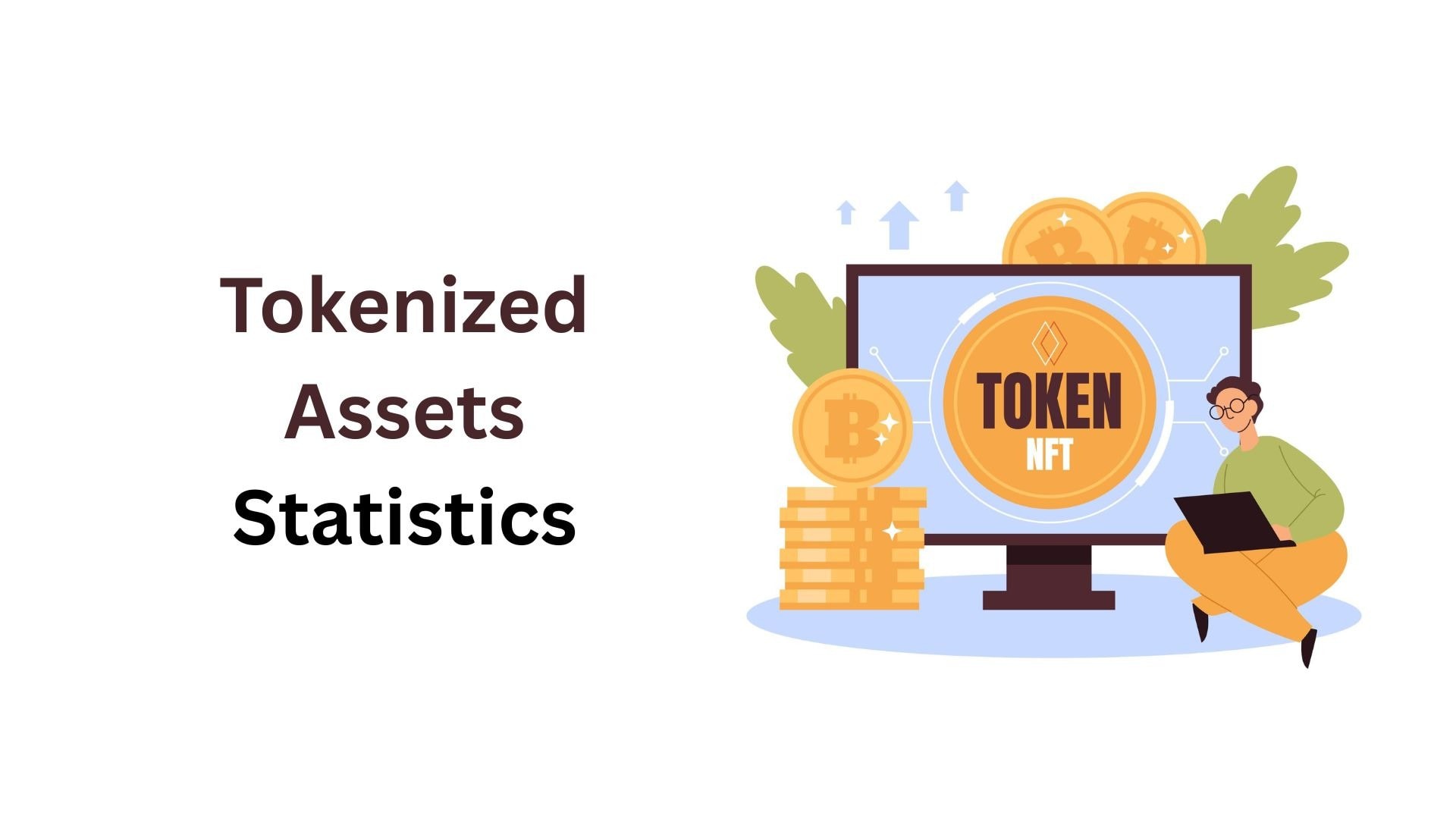
Table of Contents
- Introduction
- Editor’s Choice
- Estimated Growth In Tokenization
- Real Estate Tokenization Statistics
- Tokenized Assets Market Size
- By Segmental Analysis
- Asset Tokenisation Market Forecast by Industry
- Financial Instruments Tokenisation Statistics
- Tokenised Assets Statistics by Classes
- Real Estate Tokenization Adoption
- By Retail vs. Institutional
- By AWM Industry
- Accelerating Adoption of Tokenized Asset Classes
- Mutual Funds
- Loans and Securitization
- Bonds and Exchange Traded Notes
- Benefits of Tokenised Assets
- Conclusion
Introduction
Tokenized Assets Statistics: Tokenized assets are changing the process of people’s investments, including the buying and selling process. Assets like real estate, shares, and art can now be turned into digital tokens on the blockchain. This lets investors purchase smaller portions, complete trades faster, and maintain records with greater clarity.
The idea is gaining ground in banking, property, and alternative investment markets. As blockchain technology improves and regulations become clearer, tokenization is shifting from an emerging trend to a regular part of investing, giving people new ways to access opportunities worldwide.
Editor’s Choice
- According to Market.us, the Global Tokenized Assets Market is expected to reach USD 2,832.3 billion by 2034, rising from USD 25.8 billion in 2024.
- Real estate tokenisation is valued at about USD 20 billion, and some optimistic outlooks suggest it might rise to nearly USD 1.5 trillion by 2025.
- Meanwhile, the overall real-world assets (RWA) tokenisation market is valued at USD 24 billion in 2025, reflecting a growth of 308% in the past three years.
- By early 2025, tokenised assets in real estate, private credit, and Treasuries were valued at USD 412 billion.
- By 2025, McKinsey.com notes that the global asset tokenisation market could be about USD 0.21 trillion in real estate, USD 0.13 trillion in financial securities, and USD 0.08 trillion in loans & securitisation.
- The total market value of tokenised assets, excluding cryptocurrencies and stablecoins, is expected to grow to around USD 2 trillion by 2030.
- By early 2025, 86% of institutional investors had exposure to or planned to invest in digital assets.
- In 2024, about 1.6% of institutional investors and 5.6% of high-net-worth individuals (HNWs) had exposure to tokenised assets.
- Private credit is the largest part of tokenised assets, accounting for 61% as of April 2025.
- A coindesk.com report shows that in his month, the real-world asset (RWA) tokenisation market has grown to USD 24 billion, marking a 380% increase over the past three years.
- According to the Real-World Assets in On-chain Finance Report by RedStone, Gauntlet, and RWA.xyz, Standard Chartered projects that this market could expand dramatically, potentially reaching USD 30 trillion by 2034.
Estimated Growth In Tokenization
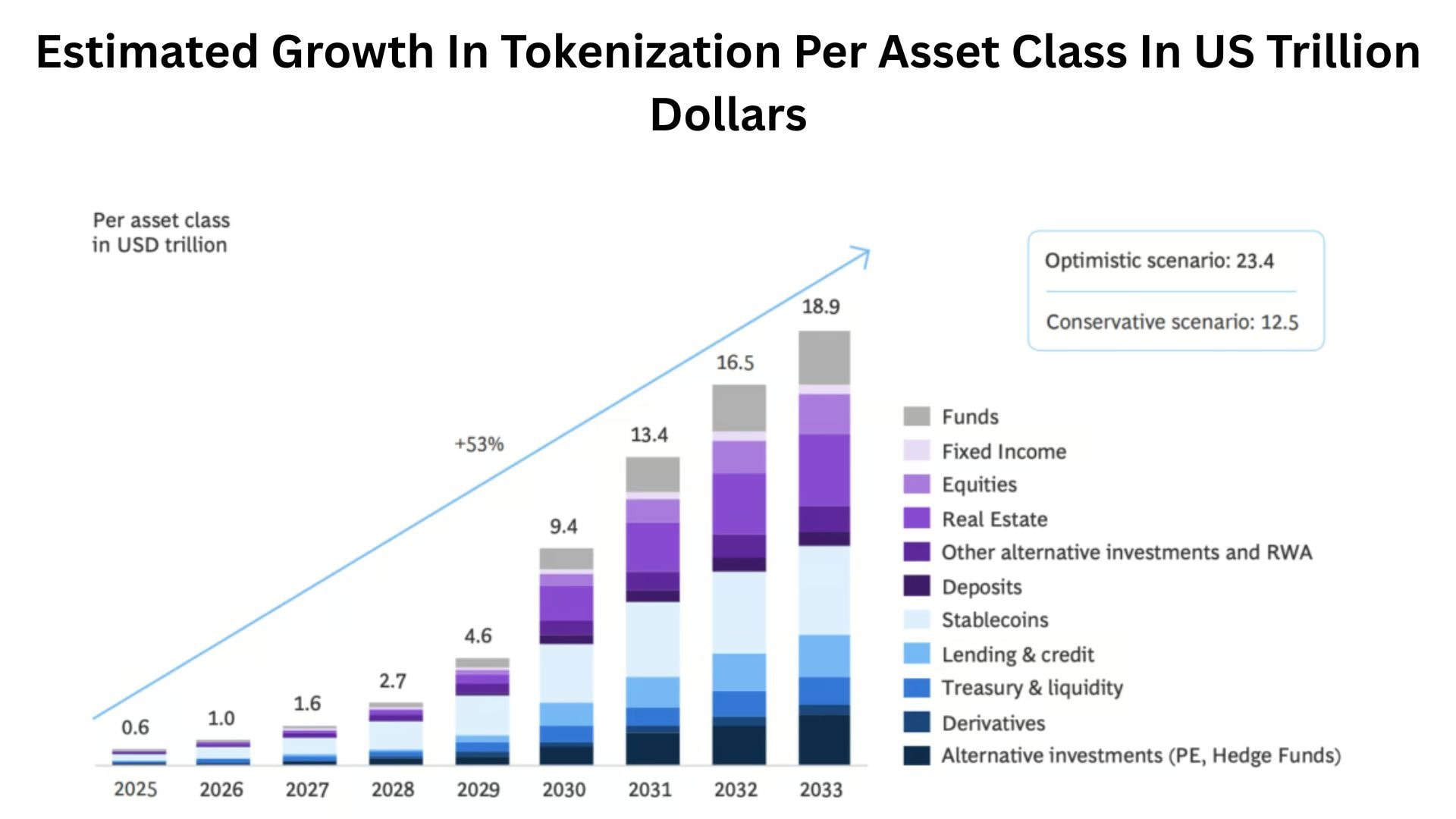
- In 2025, the total tokenised assets are estimated at 0.6 trillion USD, with steady growth reaching 18.9 trillion USD by 2033, reflecting a 53% increase over the period.
- By 2033, the optimistic scenario predicts a total of 23.4 trillion USD, while the conservative scenario estimates 12.5 trillion USD, indicating strong growth potential for digital asset markets.
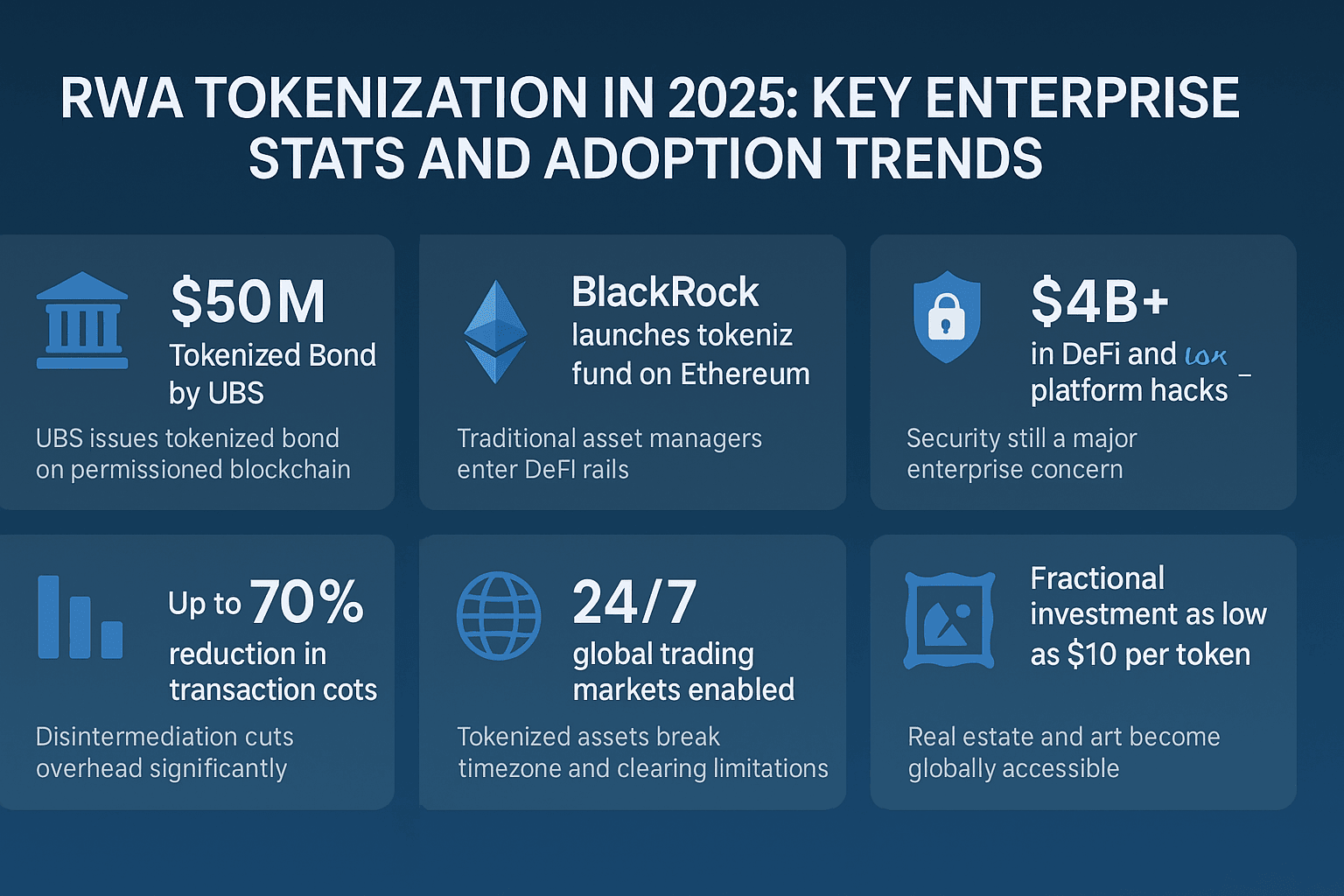
- In 2025, real-world asset tokenisation is accelerating, highlighted by UBS issuing a USD 50 million tokenised bond on a permissioned blockchain.
- Up to 70% lower transaction costs by removing intermediaries, enabling global 24/7 trading without timezone or clearing restrictions.
- Fractional investment opportunities starting at USD 10 per token.
Real Estate Tokenization Statistics
- According to global data, real estate tokens are part of a total of $412 billion in tokenized assets worldwide as of mid-2025.
- The Real-World Asset (RWA) tokenization market has reached $24 billion in 2025, showing a 308% increase over the past three years.
- By June 2025, the value of RWA tokens recorded on public blockchains was close to $18 billion.
- Deloitte has projected that tokenized private real estate funds could reach $1 trillion by 2035, representing about 8.5% of the total market.
- Global tokenized real estate is expected to reach $3 trillion by 2030, which may account for 15% of global property assets under management, depending on investor trust and regulatory clarity.
- BCG estimates that the real estate tokenization market will grow from around $120 billion in 2023 to $3.2 trillion by 2030, indicating an average annual growth rate of about 49%.
- As of June 2024, nearly 12% of global real estate companies had already adopted tokenization, while 46% were in the pilot phase.
- Real estate tokens enable fractional ownership, reduce transaction time, and lower operational costs, which improve liquidity and open investment opportunities to smaller participants.
Tokenized Assets Market Size
- The Global Tokenized Assets Market is expected to reach USD 2,832.3 billion by 2034, rising from USD 25.8 billion in 2024, with a compound annual growth rate of 60% during 2025–2034.
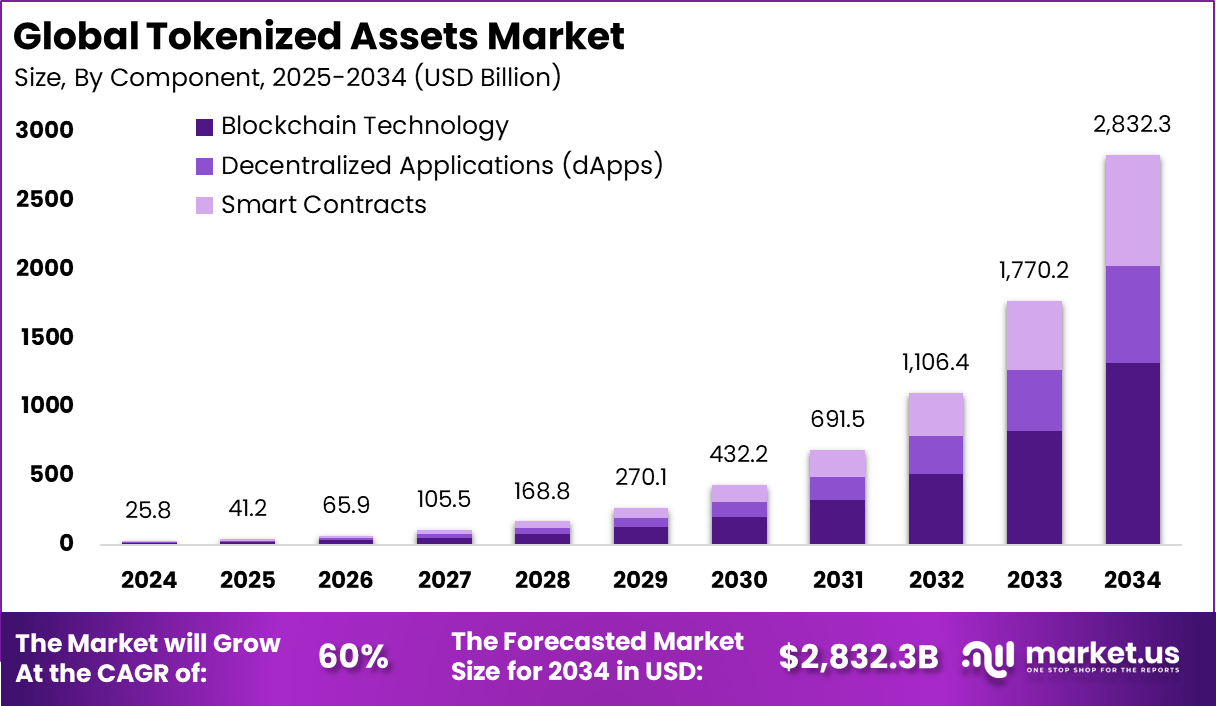
- In 2024, North America maintained dominance with over 38.8% share, recording USD 10.01 billion in revenue.
- According to Coinlaw.io, the total tokenized asset value surpassed USD 21 billion by April 2025, representing a 245-fold rise since 2020.
- Institutional investors contributed nearly 70% of the total deployed capital in 2024, showing strong confidence in digital asset efficiency and liquidity benefits.
- Tokenized treasury and money-market fund assets grew to USD 7.4 billion in 2025, reflecting an 80% increase year-to-date, supported by rising demand for transparent and efficient financial instruments.
- Real estate tokenization expanded rapidly, reaching around USD 20 billion in 2025 as property owners and investors adopted blockchain for fractional ownership.
- Market data indicates the tokenized real-world asset sector achieved a total market size of USD 24 billion in 2025, marking a 308% growth over the previous three years.
- Some forecasts suggest the tokenization industry could approach USD 1.5 trillion by 2025, depending on the progress of regulation and adoption rates.
- By component, Blockchain Technology accounted for 46.7%, reinforcing its vital role in ensuring transparency and security across asset tokenization platforms.
- By type, Security Tokens led with 53.6%, supported by investors’ preference for regulated, asset-backed instruments offering stability and trust.
- By end-use, Real Estate represented 38.8%, driven by strong demand for fractional investment models and blockchain-based ownership systems.
- Regionally, North America remained the largest market with 38.8% share, and the United States alone generated USD 8.49 billion in revenue while maintaining a 55.2% growth rate.
- As mentioned in mordorintelligence.com, clearer regulations in major financial hubs are helping the tokenised assets market grow, adding about 8.2%.
- Institutional investors and the launch of tokenised funds are giving it an even bigger push, with a 12.5% boost.
- The demand for fractional ownership in real estate is also rising, contributing 6.8%.
- Better blockchain interoperability is improving the system further, adding 7.1%.
- The adoption of ISO-20022 standards is making settlements smoother, supporting growth by 4.3%.
- Meanwhile, the introduction of tokenised carbon-credit instruments is adding another 3.9% to the market’s momentum.
By Segmental Analysis
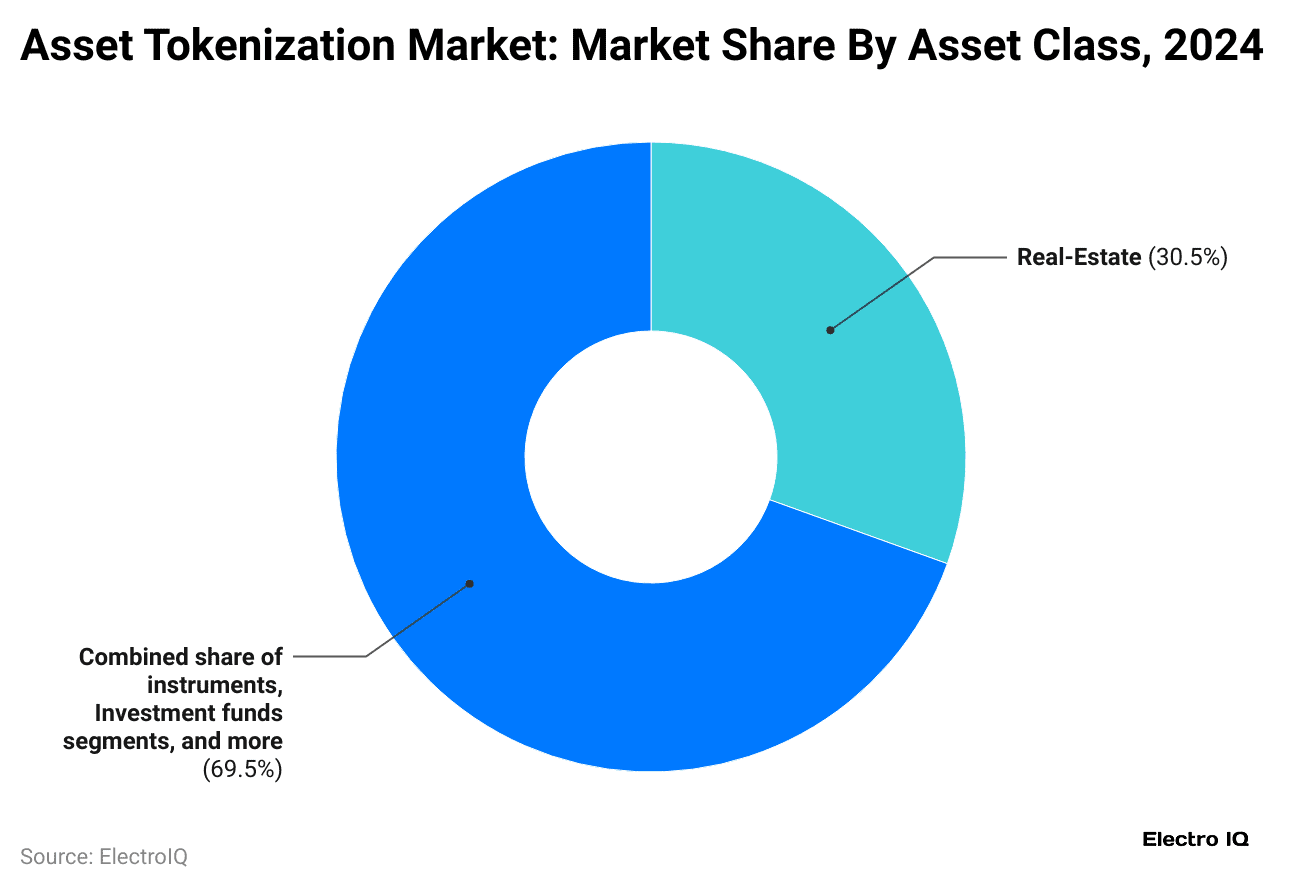
- A report published by Mordor Intelligence in 2024 states that, based on asset class, real estate led the market with a share of 30.50% and the combined share of debt instruments, investment funds segment, and more secured a share of 69.5%.
- Investor type, institutional investors dominated participation, accounting for 69.80% of activity.
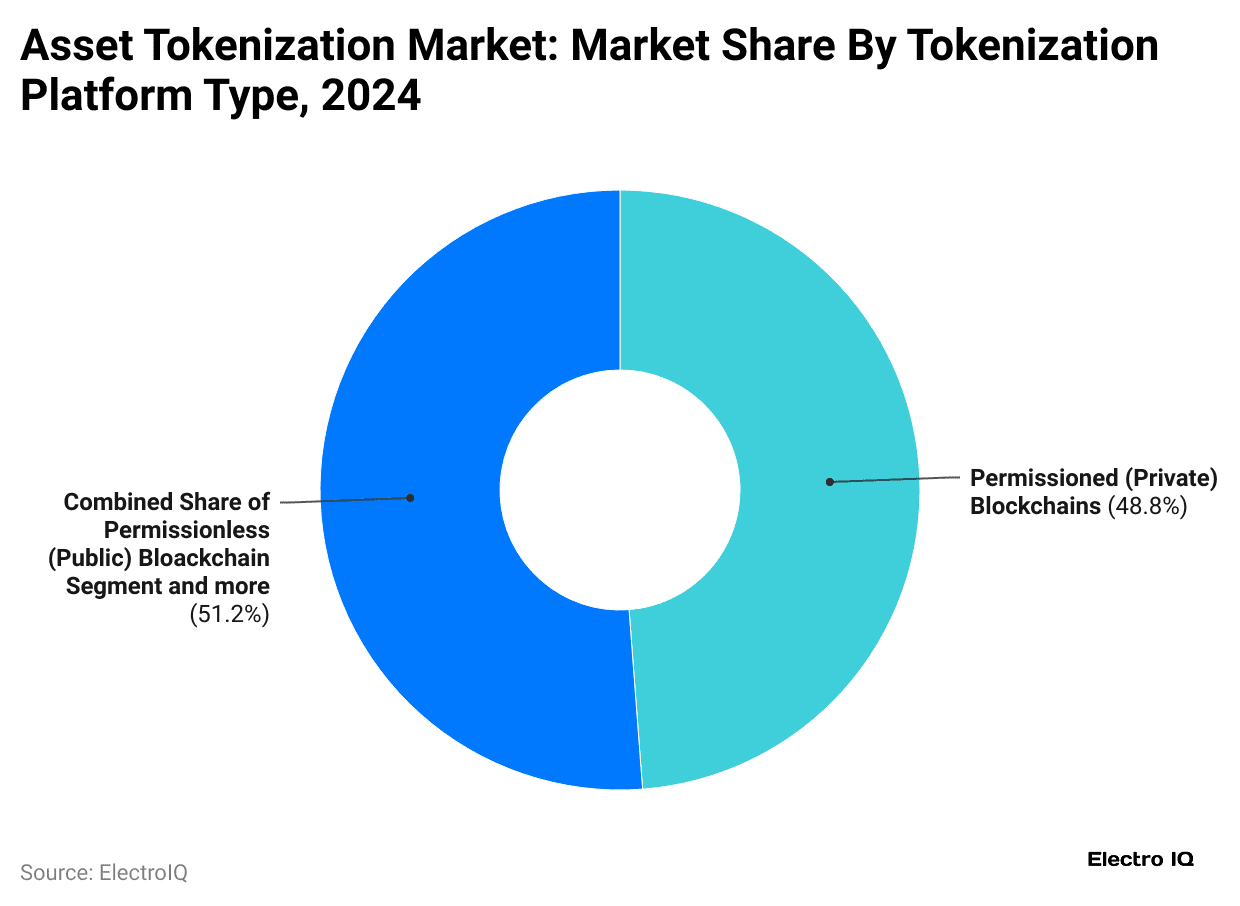
- When it comes to platform type, permissioned blockchains were preferred, holding 51.20% of the market and a combined share of the permissionless (public) blockchains segment, and secured around 48.8%.
- In terms of offerings, tokenisation platforms and middleware captured the largest portion at 59.60%.
- Geographically, North America remained the leading region, representing 39.60% of the overall market share.
Other segmental annual growth rates are estimated below:
| Segments | CAGR (From 2024 to 2030) |
| Commodities | 50.10% |
| Retail | 52% |
| Permissionless networks | 53.20% |
| Legal-technology services | 49.40% |
| Asia-Pacific | 55.40% |
Asset Tokenisation Market Forecast by Industry
- By 2025, McKinsey.com notes that the global asset tokenisation market could be about USD 0.21 trillion in real estate, USD 0.13 trillion in financial securities, and USD 0.08 trillion in loans & securitisation.
- Meanwhile, roughly USD 0.03 trillion each in commodities and art or luxury assets.
The forecasted market size of real-world asset tokenisation in the coming year is stated below:
| Year | Real Estate | Financial Securities | Loans and Securitisation | Commodities | Art and Luxury |
| USD trillion | |||||
| 2026 | 0.27 | 0.17 | 0.10 | 0.03 | 0.03 |
| 2027 | 0.35 | 0.22 | 0.13 | 0.04 | 0.04 |
| 2028 | 0.46 | 0.29 | 0.17 | 0.06 | 0.06 |
| 2029 | 0.61 | 0.38 | 0.23 | 0.08 | 0.08 |
| 2030 | 0.80 | 0.50 | 0.30 | 0.10 | 0.10 |
Financial Instruments Tokenisation Statistics
- According to coinlaw.io, in 2025, tokenised money-market and Treasury fund assets jumped 80%, reaching about USD 7.4 billion.
- Institutional tokenisation of real-world assets (RWAs) involved over 200 projects with a total value locked of USD 65 billion, up 800% from 2023.
- Tokenised equities are appearing on platforms like Coinbase and Robinhood, but face legal limits.
- Overall, tokenised assets rose from USD 85 million in 2020 to over USD 21 billion by April 2025, with forecasts projecting growth to USD 18.9 trillion by 2033.
Tokenised Assets Statistics by Classes
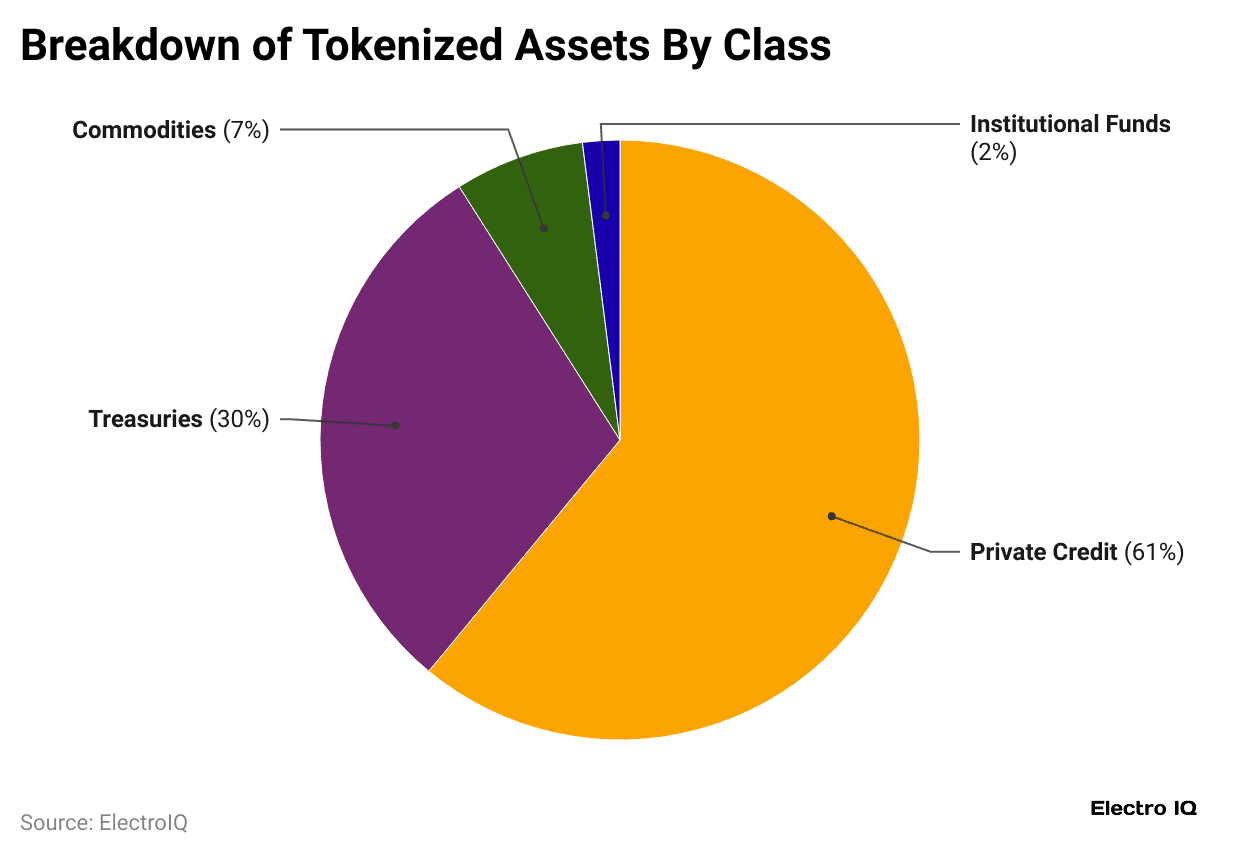
- Private credit is the largest part of tokenised assets, accounting for 61% as of April 2025.
- Treasuries made up 30%, commodities 7%, and institutional funds 2%
Real Estate Tokenization Adoption
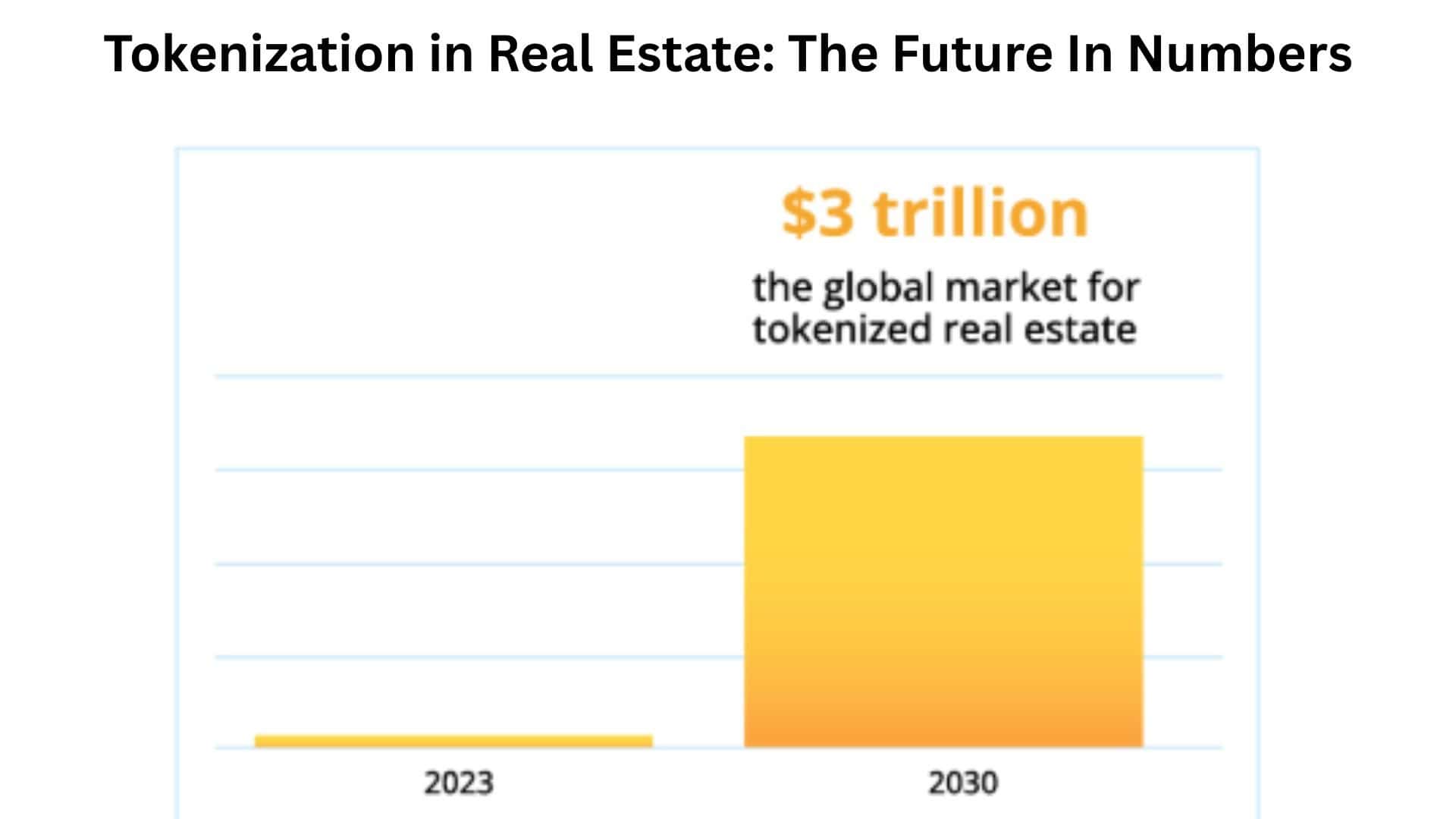
- ScienceSoft’s research team predicts tokenised real estate could hit USD 3 trillion by 2030, representing 15% of real estate assets.
- In 2025, 67% of investors have already invested in tokenised assets, and 62% of them are planning to invest more in tokenised assets as the market is maturing rapidly..
- Meanwhile, 55% of real estate sellers have already launched tokenisation solutions.
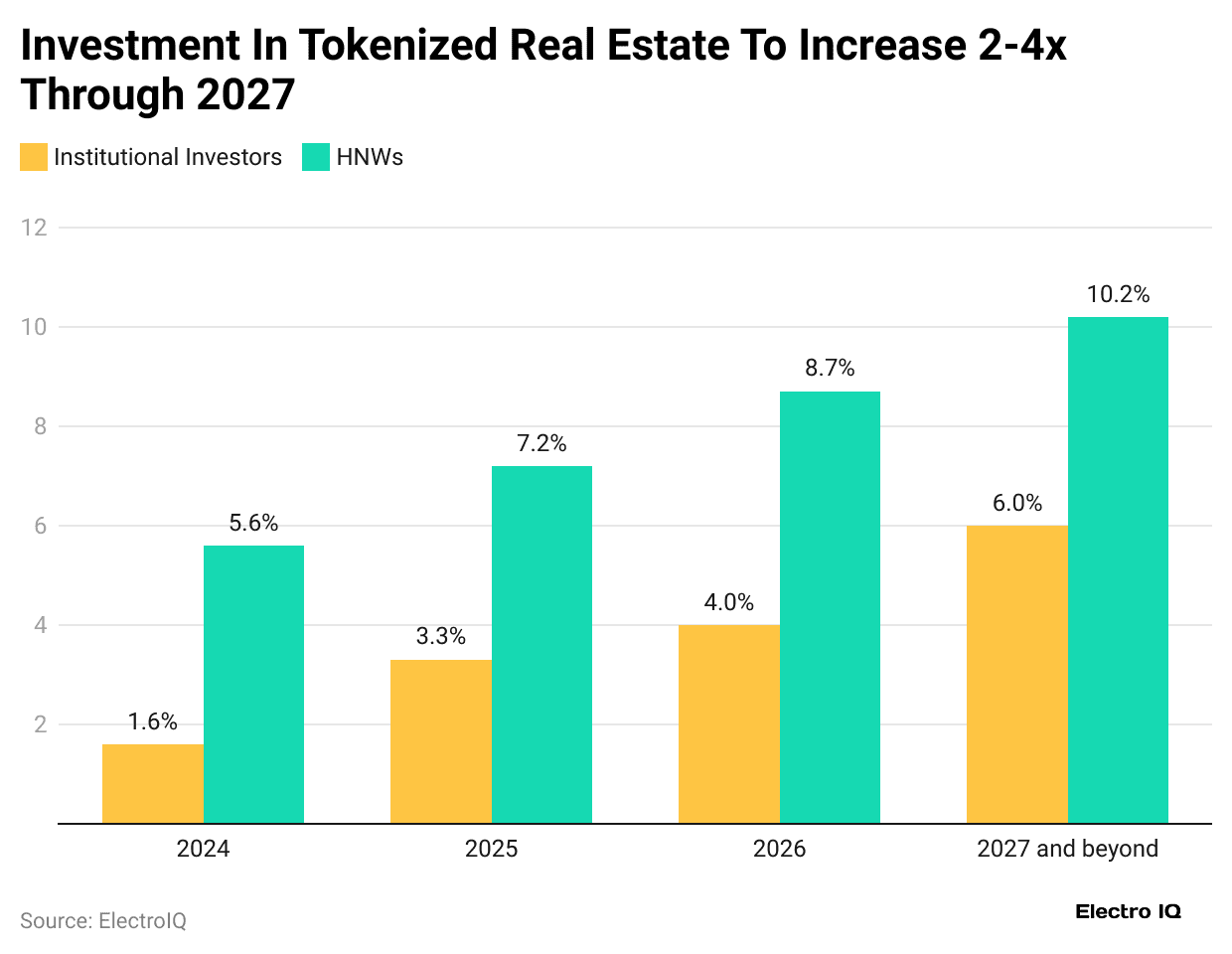
- In 2024, about 1.6% of institutional investors and 5.6% of high-net-worth individuals (HNWs) had exposure to tokenised assets.
- This share is expected to grow in 2025, and participation may rise to 3.3% for institutions and 7.2% for HNWs.
- In 2026, the figures could reach 4% for institutions and 8.7% for HNWs, while by 2027 and beyond, adoption is projected at 6% among institutions and 10.2% among HNWs.
By Retail vs. Institutional
- By early 2025, 86% of institutional investors had exposure to or planned to invest in digital assets.
- By 2026, high-net-worth individuals and institutions aim to allocate 8.6% and 5.6% of their portfolios, respectively, to tokenised assets.
- Over 60% of all investors are already investing or planning to, with real estate preferred.
- Over 200 institutional RWA projects are already underway, supported by more than 40 leading financial institutions.
- At the same time, Coinbase reports allocations of 2% to institutions, 61% to private credit, and 30% to treasuries.
By AWM Industry
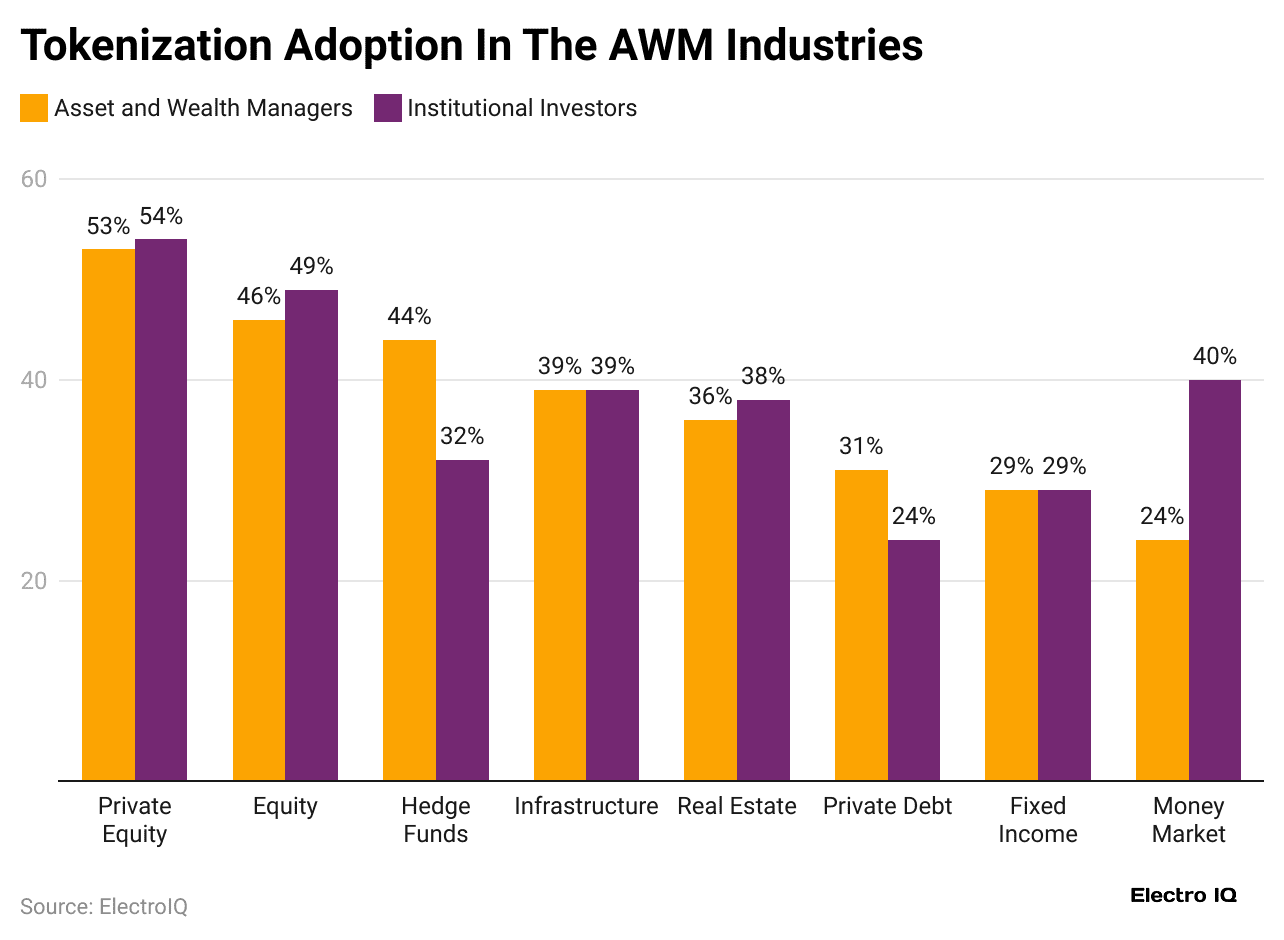
- Private equity accounted for the highest adoption, with 53% of asset and wealth managers and 54% of institutional investors participating.
- Equity tokens attract 46% of managers and 49% of institutions.
- Hedge funds appeal to 44% of managers versus 32% of investors.
- Infrastructure sees 39% adoption in both groups.
- Real estate, private debt, fixed income, and money market tokens show varied interest, ranging from 24% to 40%.
Accelerating Adoption of Tokenized Asset Classes
According to McKinsey, the adoption of tokenization across asset classes is advancing steadily and is expected to accelerate as network effects strengthen. Certain categories are likely to reach widespread use more quickly, defined as exceeding 100 billion USD in tokenized market capitalization by the end of the decade. These include cash and deposits, bonds and exchange-traded notes, mutual funds and exchange-traded funds, as well as loans and securitized products. Many of these assets are already showing meaningful adoption, supported by the efficiency and value improvements that blockchain technology provides, along with favorable technical and regulatory conditions.
It is estimated that the total tokenized market capitalization across these asset classes could reach around 2 trillion USD by 2030, excluding cryptocurrencies and stablecoins. The possible range extends from about 1 trillion USD in a conservative scenario to approximately 4 trillion USD in an optimistic one. Stablecoins, tokenized deposits, wholesale stablecoins, and central bank digital currencies are excluded from this calculation to prevent duplication, as they often serve as the payment leg in transactions involving tokenized assets.
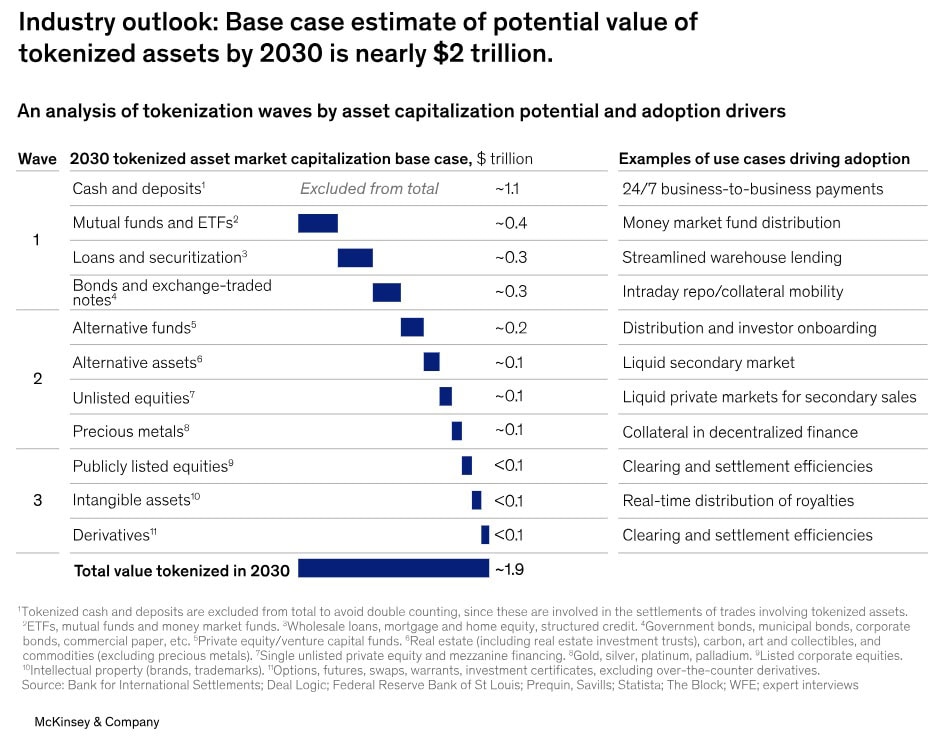
(Source: mckinsey.com)
Mutual Funds
- According to industry insights, tokenized money market funds have already attracted over $1 billion in assets under management, reflecting rising investor confidence in blockchain-based investment products.
- Tokenized mutual funds are becoming more popular among investors who hold digital assets and want exposure to traditional markets in a high-interest-rate environment.
- Investors can now choose between funds managed by well-known financial institutions like BlackRock, WisdomTree, and Franklin Templeton, as well as blockchain-native firms such as Ondo Finance, Superstate, and Maple Finance.
- Demand for tokenized money market funds is expected to remain strong as long as interest rates stay high, as these funds can serve as a more stable store of value compared to stablecoins.
- Other categories of mutual funds and ETFs could also move on-chain, offering digital asset holders a chance to diversify their portfolios through familiar financial instruments.
- Transitioning mutual funds to blockchain systems can enhance their overall utility by allowing instant 24/7 settlement and enabling tokenized funds to be used directly for payments.
- As tokenized funds expand in scope and adoption, additional advantages such as faster operations, greater transparency, and lower technology costs are likely to emerge.
- Investors and fund managers will benefit from shared ledger data, which minimizes manual errors and reconciliation issues, leading to more efficient fund management.
- Over time, blockchain-based fund structures could also enable the creation of customized investment strategies by combining multiple tokenized assets in flexible and programmable ways.
- While the demand for tokenized money market funds remains partly tied to interest rate trends, their current momentum represents the first strong sign of broader adoption for tokenized investment vehicles.
Loans and Securitization
- According to McKinsey, blockchain-based lending is still in the early stages but is starting to gain attention, with companies such as Figure Technologies leading in nonbank home equity lending in the United States and recording several billion in loan originations.
- It has been observed that Web3 platforms such as Centrifuge and Maple Finance, along with Figure and others, have already facilitated more than $10 billion in loans that involve blockchain technology.
- Tokenization in lending is expected to grow further, especially in areas like warehouse lending and the securitization of on-chain loans, as financial institutions seek greater transparency and automation.
- Traditional lending involves complex and labor-intensive processes, including multiple intermediaries, manual reporting, and slower transaction cycles, which increase both time and cost for borrowers and lenders.
- Blockchain-based lending uses a unified master ledger where all data are recorded transparently on-chain, creating a single source of truth that helps reduce errors and promotes consistency throughout the lending life cycle.
- Smart contracts automate many lending functions, including payout calculations and reporting, reducing the need for manual work and significantly lowering operational costs.
- Faster settlement cycles and access to a global pool of investors make blockchain-enabled lending more efficient and potentially reduce the overall cost of capital for borrowers.
- Future developments may include tokenizing borrower financial metadata and real-time monitoring of on-chain cash flows, which can improve credit scoring accuracy and allow fully automated underwriting.
- As private credit markets expand, borrowers are likely to benefit from faster processing, lower fees, and more equitable terms supported by blockchain transparency and automation.
- Growing interest among Web3-native users and institutions adopting digital assets is expected to accelerate blockchain-based loan issuance and on-chain securitization in the coming years.
Bonds and Exchange Traded Notes
- According to McKinsey, the global market has seen over $10 billion worth of tokenized bonds issued in the past ten years, compared with a total global notional bond value of about $140 trillion.
Recent issuers include Siemens, the City of Lugano, and the World Bank, along with other government and corporate entities. - Blockchain-based repurchase agreements have also gained attention, processing transactions worth trillions of dollars each month in North America. These digital repo trades have helped reduce operational costs and capital inefficiencies in financial markets.
- Digital bond issuance is expected to continue rising as countries and companies recognize the benefits of blockchain integration in capital markets. In regions such as Thailand and the Philippines, tokenized bond programs have encouraged small-scale participation through fractional investment opportunities.
- End-to-end tokenized bond systems can enhance operational efficiency by nearly 40 percent, primarily by improving data accuracy, automating workflows, and embedding compliance into token-level transactions.
- Tokenization also lowers issuance costs and shortens processing time. It enables smaller issuers to access “just-in-time” financing, which allows them to raise specific amounts of funds when needed while reaching a broader global investor base through digital distribution.
Benefits of Tokenised Assets
- Liquidity improves because turning assets like real estate or gold into tokens makes trading simple.
- Expensive assets can be divided into small parts, allowing more people to invest.
- Tokens are available for trade anytime and anywhere, without geographical barriers.
- Fewer middlemen mean lower fees and better returns for investors.
- Blockchain records ownership safely and transparently, helping to stop fraud.
Conclusion
Tokenised assets are reshaping the way individuals and businesses purchase, trade, and hold both traditional and alternative investments. With the help of blockchain, transactions become clearer, quicker, and more convenient compared to regular markets. As rules get better and adoption grows, tokenised assets are expected to play a larger role in global finance. They point to a future where moving and owning value is easier, more secure, and accessible to all.
FAQ.
A token represents ownership of an asset. Blockchain records and verifies every transaction, making trading secure, transparent, and fast.
Anyone with access to the platforms offering these tokens. Some tokens may require accredited investor status depending on local laws.
Yes, like any investment, they carry risks like volatility, lack of liquidity in some tokens, platform security risks, and changes in regulations.

Maitrayee Dey has a background in Electrical Engineering and has worked in various technical roles before transitioning to writing. Specializing in technology and Artificial Intelligence, she has served as an Academic Research Analyst and Freelance Writer, particularly focusing on education and healthcare in Australia. Maitrayee's lifelong passions for writing and painting led her to pursue a full-time writing career. She is also the creator of a cooking YouTube channel, where she shares her culinary adventures. At Smartphone Thoughts, Maitrayee brings her expertise in technology to provide in-depth smartphone reviews and app-related statistics, making complex topics easy to understand for all readers.





